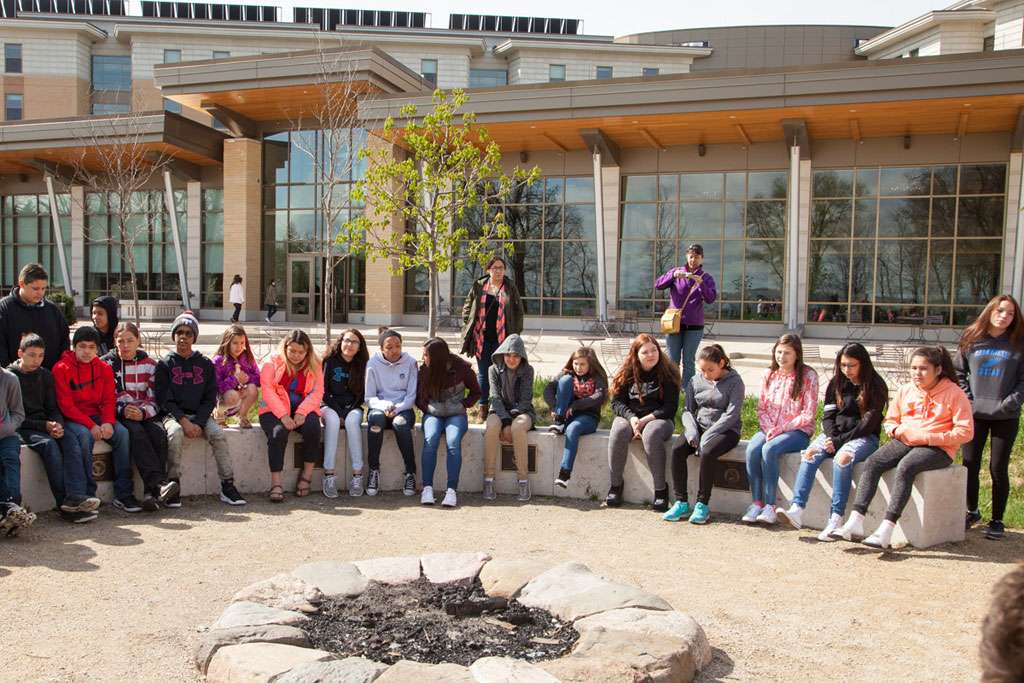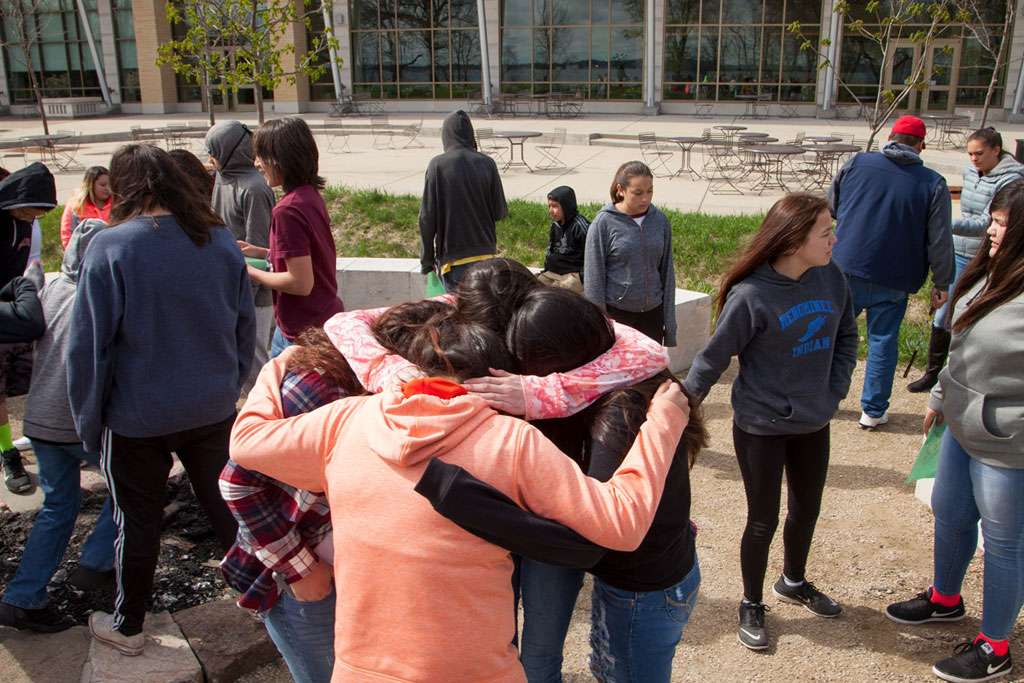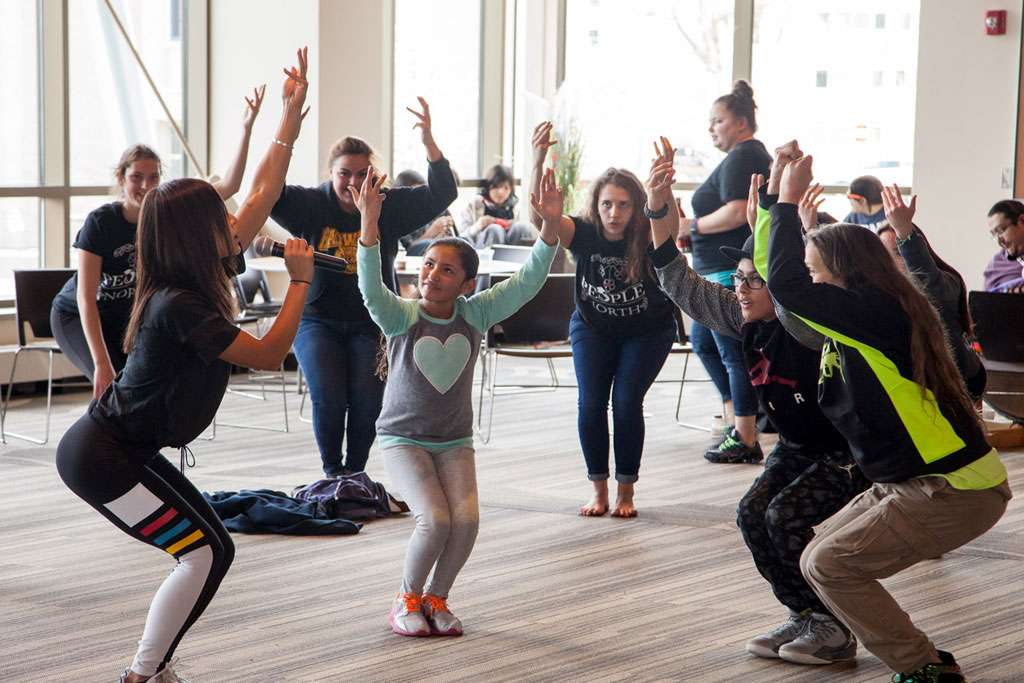With a focus on blending elements of indigenous culture and college culture, the University of Wisconsin School of Medicine and Public Health’s (SMPH) Native American Center for Health Professions (NACHP) welcomed 83 Native American middle and high school students from throughout Wisconsin to UW–Madison in late April 2017.
The youth explored the rich history of the campus region, including the centuries-old effigy mounds in the Lakeshore Preserve near the event’s hub, Dejope Hall. The NACHP offers innovative ways to enhance recruitment of Native American health professions students and engage students with Native health and wellness.
Putting the “We” in Wellness
With the goal of putting the “We” in Wellness, the 13th annual Indigenous Health and Wellness Day provided training for students to learn simple ways to incorporate fitness and relaxation strategies into their lives and shared opportunities for them to learn about health sciences careers and required training, directly from UW–Madison health sciences professionals and students.

The action-packed day was organized in collaboration with Madison College, the Great Lakes InterTribal Council, Wisconsin Council on Children and Families, UW Health and Unity Health Insurance. Their goals included encouraging young students to explore and learn more about campus life, which included hearing from American Indian students who have navigated pre-college and college programs, and health care professionals.
“We want to help the young students increase their knowledge about college and how to prepare for it. This is the first time many of them have visited a large college campus,” says Melissa Metoxen, community academic and support coordinator for the NACHP. “We want them to be able to picture themselves attending college.”
Resource Fair Offers Hands-on Activities

With this in mind, 12 organizations and groups from across campus participated in a resource fair, which provided the students with hands-on activities, such as learning how to fill prescriptions. “If we can get any of the students thinking, ‘I want to go into nursing or medical school or become a pharmacist,’ we will have made progress,” says Metoxen, adding that a former participant in Indigenous Health and Wellness Day earned a degree in human development studies at UW–Madison in 2016 and now works for the SMPH.
This year’s 34 high school and 49 middle school students represented eight Native American communities from throughout Wisconsin. Their day began with a welcome song and blessing by Alton “Sonny” Smart, PhD, from Bad River Ojibwe and drumming by Little Thunder of the Ho-Chunk Nation. Keynote speakers were the co-founders of Well for Culture, Chelsey Luger of Anishinaabe/Lakota and Thosh Collins of O’odham/Haudenosaunee/Wa-Zha-Zhi. Luger and Collins shared wellness-related topics from indigenous and western perspectives, and they focused on the importance of mind and body health.

“Well for Culture aims to dispel harmful myths and offer ways to improve public health in Native communities. They look to the history of Native peoples and their own lives to find a healthy life balance by connecting the mental, physical, spiritual and emotional facets of life,” says Metoxen, adding that they taught the students fun exercises that could be done at any level to promote balance and strength of body and mind, and led indigenous-themed games. Students took walking tours to visit the 30-year-old Tree of Peace and effigy mounds around the area of Observatory Hill. At the end of the tour, students gathered at Dejope Hall’s fire circle, which features plaques and symbols of Wisconsin’s tribes. Using crayons and paper, they created keepsake impressions of the emblems.
Several campus leaders addressed the group, and the afternoon resource fair provided opportunities for students to learn about support programs and social organizations at UW–Madison. A video presentation by representatives from the PEOPLE Program (Pre-College Enrichment Opportunity Program for Learning Excellence) illustrated a project in which university students had interviewed friends about how it feels to be a Native student on a predominantly white campus.
A question and- answer session gave viewers a chance to learn more from peers and offer insights. As students said goodbye to UW–Madison — while Little Thunder performed a travel song — Indigenous Health and Wellness Day organizers remained hopeful that some would return. They were thrilled when they saw a favorable statistic on the post-event evaluation: 76 percent of the students who submitted the survey indicated, “Yes — I am interested in attending college.”